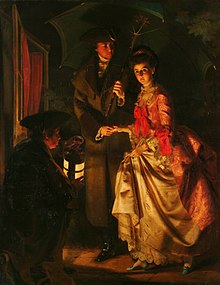
Love in Bath is an orchestral suite, with one vocal number, arranged in 1945 from the music of George Frideric Handel by the conductor Sir Thomas Beecham for a projected ballet entitled The Great Elopement.[1] It was the last of six suites of Handel's music arranged by Beecham from 1924 onwards.
It was first heard in a broadcast by the American Broadcasting Symphony Orchestra, conducted by Beecham, on 7 April 1945. The first concert performance followed five days later, by the Rochester Philharmonic under Beecham.[2] He continued to include movements from the work in his programmes for the rest of his life, and it featured in his final concert, in May 1960, less than a year before he died.[3]
The music has been recorded, but the projected ballet was never staged. The scenario, conceived and written by Beecham, is loosely based on real events. Set in 18th-century Bath, it depicts the love affair and elopement of the playwright Richard Brinsley Sheridan and Elizabeth Linley (daughter of the composer Thomas Linley), in the elite society of Bath, presided over by the dandy Beau Nash.[2]
The music is mostly taken from Handel's operas, which in Beecham's day were rarely staged and were widely considered unstageable. Beecham researched the scores of many of them and for this ballet he exhumed forgotten numbers from operas including Ariodante, Il pastor fido, Parnasso in festa and Rodrigo, adding at the climax the only well-known number in the score, the "Largo" – "Ombra mai fu" – from Serse, transcribed for the full orchestra.[2]